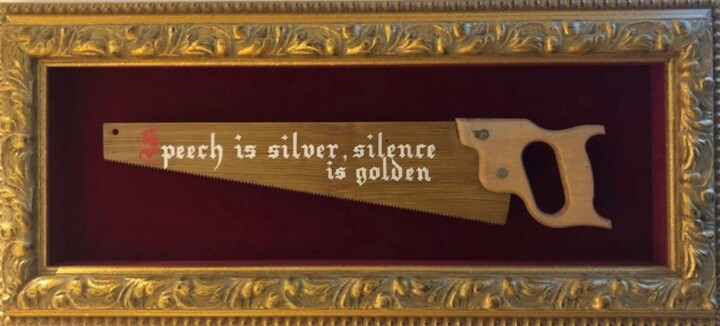 Wim Delvoye in 2015 at BPS22 in Charleroi. Author: Jmh2o, via Wikipedia
Wim Delvoye in 2015 at BPS22 in Charleroi. Author: Jmh2o, via Wikipedia
Wim Delvoye
Wim Delvoye is a contemporary Belgian neo-conceptual artist renowned for his inventive and often provocative works that merge philosophical concepts with a masterful use of materials and a deep appreciation for craftsmanship. Born in 1965 in Wervik, Belgium, Delvoye has gained international recognition for his ability to challenge traditional boundaries in art by merging high and low culture, and by exploring themes such as bodily functions, industrial processes, and the intersection of art and technology.
Delvoye grew up in Wervik, a small town in West Flanders, Belgium. His early exposure to art exhibitions with his parents fostered a passion for drawing, which eventually led him to study at the Royal Academy of Fine Arts in Ghent. Delvoye has remarked that the low expectations placed on Belgian art students gave him a sense of freedom, making him realize he "had nothing to lose." This mindset soon inspired him to challenge the prevailing trend of free expression in the art world by painting over wallpaper and carpets, creatively coloring in existing patterns.
Wim Delvoye's artistic journey draws from various facets of art history, encompassing inspirations from Gothic cathedrals and 19th-century sculptures, as well as the works of Bosch, Brueghel, and Warhol. He reveals beauty in everyday objects through a baroque approach that balances homage with irreverence, appropriating and distorting motifs that capture his imagination. Delvoye sees himself as an originator of concepts, more intrigued by the theory behind pieces than the act of creation itself. Since 1990, most of his works have been executed by specialists under his direction.
In the late 1980s, Delvoye applied Dutch ornamental traditions, such as Delft china patterns and coats of arms, to mundane objects like shovels, gas cylinders, and ironing boards. His international recognition came in 1992 with the presentation of his "Mosaic" at Documenta IX, a symmetrical display of glazed tiles featuring photographs of his own excrement. Jan Hoet, the organizer of Documenta IX, praised Delvoye's ability to engineer conflict by combining fine arts and folk art, and juxtaposing seriousness with irony.
 Wim Delvoye - Speaking is silver, silence is gold
Wim Delvoye - Speaking is silver, silence is gold
In the 1990s, Delvoye experimented with tattoo art on pigskin, exhibiting live pigs and dried skins covered in tattoos depicting biker and punk rock imagery like skulls, daggers, and Harley Davidson logos. By 2004, he expanded this medium to include stuffed pigs adorned with Louis Vuitton patterns and images of Disney princesses, raising questions about the commercial value of brands and challenging consumer society's expectations.
Delvoye gained widespread attention in the 2000s with his Cloaca project, a machine that simulates the human digestive system, fundamentally redefining the critical function of art. This work, both shocking and intellectually stimulating, critiques consumerism and the mechanization of life while blurring the lines between art, science, and engineering. Cloaca, marked by a logo parodying Mr. Clean and Coca-Cola, reflects the commercialized mass market by converting food into realistic waste. It exemplifies the mechanisms of the modern economy and the potential for endless market manipulation, paradoxically gaining commercial value as an artwork that produces new artwork.
Since the early 2000s, Delvoye's Gothic works have explored the blend of historical artistic styles with modern monumentality. Using laser-cut corten steel, he crafts neo-Gothic tracery that transcends mere decoration to become symbols of contemporary value and permanence. His "Gothic Works" series further exemplifies this fascination, featuring sculptures like Gothic-styled cement mixers and bulldozers that combine intricate detail with a sense of historical and cultural significance, demonstrating his skill in infusing industrial objects with Gothic grandeur. His art, often characterized by its playful yet critical engagement with societal norms, continues to provoke thought and spark debate in the contemporary art world.
Cloaca works
Delvoye is perhaps best known for his digestive machine, Cloaca, which he unveiled at the Museum voor Hedendaagse Kunst in Antwerp after eight years of consultation with experts ranging from plumbing to gastroenterology. As a commentary on the Belgians' love of fine dining, Cloaca is a large installation that turns food into feces, allowing Delvoye to explore the digestive process. In this intricate mechanism, food starts at a long, transparent bowl (mouth), travels through a series of machine-like assembly stations, and ends as hard matter, separated from liquid through a cylinder. Delvoye collects and sells the realistically smelling output, suspended in small jars of resin at his Ghent studio.
When asked about his inspiration, Delvoye stated that everything in modern life is pointless, and the most useless object he could create was a machine that serves no purpose at all, besides reducing food to waste. Cloaca has appeared in many versions, including Cloaca Original, Cloaca – New & Improved, Cloaca Turbo, Cloaca Quattro, Cloaca N° 5, and Personal Cloaca. Delvoye also sold specially printed toilet paper as a souvenir of the exhibit. In 2016, five rolls from the 2007 Mudam Luxembourg exhibit were offered for resale for $300 through an online vendor.
Previously, Delvoye claimed that he would never sell a Cloaca machine to a museum as he could never trust that the curator would maintain the installation properly. However, after two years of discussion with David Walsh, Delvoye agreed to construct a custom Cloaca specifically for the Museum of Old and New Art in Hobart, Tasmania. The new installation is suspended from the museum ceiling in a room custom-built for it.
Gothic works
Delvoye is also renowned for his "gothic" style work. In 2001, he collaborated with a radiologist to have several friends paint themselves with small amounts of barium and engage in explicit sexual acts in medical X-ray clinics. He then used the resulting X-ray scans to fill gothic window frames instead of traditional stained glass. Delvoye suggests that radiography reduces the body to a machine. While not an active participant, Delvoye observed the process from a computer screen in another room, allowing the subjects enough distance to perform normally. He described the operation as "very medical, very antiseptic."
Delvoye also creates oversized laser-cut steel sculptures of objects typically found in construction, such as cement trucks, customized in seventeenth-century Flemish Baroque style. These structures juxtapose "medieval craftsmanship with Gothic filigree," blending the heavy, brute force of contemporary machinery with the delicate artistry associated with Gothic architecture. In a 2013 exhibition in New York City, Delvoye displayed intricate laser-cut works that combined architectural and figurative references with shapes like Möbius bands and Rorschach inkblots.
Wim Delvoye continually navigates between opposing realms, such as the sacred and the profane or the local and the global, using sarcasm to challenge the myths that underpin contemporary society, including those related to religion, science, and capitalism, through unexpected hybridizations.
Exhibitions and collections
Throughout his career, Delvoye has exhibited his works in numerous prestigious museums and galleries worldwide, including the Venice Biennale in 1990 and 1999, Documenta IX in 1992, and the notable presentation of "Cloaca" at the New Museum in New York in 2002. Significant solo exhibitions include those at the Peggy Guggenheim Collection in Venice (2009), Musée d’Art Moderne et d’Art Contemporain in Nice (2010), Musée Rodin in Paris (2010), Palais des Beaux-Arts (BOZAR) in Brussels (2010-2011), the Museum of Old and New Art in Hobart, Tasmania (2012), and the Musée du Louvre (2012). More recent solo exhibitions were held at the Heydar Aliyev Center in Baku (2015), Tehran Museum of Contemporary Art (2016), MUDAM in Luxembourg (2016-17), DHC/ART Foundation in Montreal (2016-17), and the Tinguely Museum in Basel (2017-18). Delvoye’s work was also featured in a solo exhibition at the Royal Museums of Fine Arts of Belgium, Brussels (2019).
His works are held in numerous public collections around the world. In Belgium, they are featured in institutions such as the AWZ & City of Middelkerke, The Belgacom Art Collection, Brussels Regional Parliament, Belfius Art Collection, City of Anderlecht, City of Brussels, City of Evergem, City of Ghent, City of Knokke, City of Wervik, Collection Katoennatie, The Flemish Art Collection, IDEA, ING Art Center, Middelheim Sculpture Park, MuHKA, Musée d'Ixelles, National Bank of Belgium, PMMK, Province of Henegouwen, SMAK, and the University of Antwerp. In France, his works are part of the collections at CAPC Bordeaux, Centre Georges Pompidou, Espace Claude Berri, FNAC, Fondation Cartier, Fondation d’art contemporain Florence & Daniel Guerlain, Fondation Salomon, FRAC Aquitaine, FRAC Auvergne, FRAC des Pays de la Loire, FRAC Pays de la Loire, FRAC Limousin, Musée d'Art Moderne in Saint-Etienne and Strasbourg, Musée de Rouen, Musée du Louvre, and Cité de Roubaix. In Germany, his works are included in the Collection Olbricht, DZ Bank AG, and Museum Kunst-Palast. In Greece, his art is held by the Deste Foundation in Athens. In Iran, it is featured in TomcA, Tehran, and in Israel, it is part of The Israel Museum in Jerusalem. In Italy, his works are in the Collection Castello di Rivoli and Parco Archeologico di Scolacium. Luxembourg holds his works in the City of Luxembourg, Mudam, and Collection Grand-Duchesse de Luxembourg. In the Netherlands, they are part of the Stedelijk Museum and Collection Interpolis. Norway’s Museet for Samtidskunst in Oslo, Portugal’s Centro Modulo in Lisbon, South Korea’s Kimpo Sculpture Park, Spain’s Diputación de Granada, Sweden’s Magasin III in Stockholm, and Switzerland’s UBS Art Collection also feature his works. In Tasmania, his art is part of MONA, and in the United States, it is included in the Collection Peter Norton, Guggenheim Museum, Museum of Contemporary Art in San Diego, Stained Glass Museum in Chicago, The Cartin Collection in Hartford, and The Margulies Collection at the Warehouse in Miami. In China, his works are displayed at Jing'An Sculpture Park in Shanghai.


 Selena Mattei
Selena Mattei

